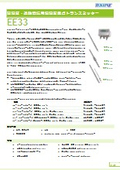About CO2 absorption concrete: thermometer and hygrometer.
Introduction of a thermometer for managing the carbon dioxide (CO2) absorption concrete experimental furnace.
The development of concrete that absorbs CO2 is underway. Using industrial by-products such as calcium carbonate (CaCO3) and those emitted from steel mills, thermal power plants, cement factories, and chemical plants (such as blast furnace slag), the development of concrete that absorbs carbon dioxide (CO2) is progressing. The reaction between cement and CO2 leads to carbonation, allowing for the absorption and retention of CO2. Additionally, it can maintain a strongly alkaline environment internally, which enhances durability and is expected to increase longevity. *Current concrete is made by mixing raw materials such as limestone and clay, followed by drying, grinding, and sintering (referred to as clinker), after which gypsum is added and powdered.* This development has garnered attention, being featured in the Ministry of Economy, Trade and Industry's "Green Growth Strategy for Carbon Neutrality by 2050" under the "Carbon Recycling Industry." In this development, managing the atmosphere's dry and wet conditions is necessary, and thermometers and hygrometers (thermo-hygrometers) that can withstand high temperatures and high humidity are used in experimental furnaces.
basic information
At Tekune Measurement, we have measuring instruments and devices tailored to your needs. We offer dew point meters and anemometers for dew point and moisture management, as well as thermohygrometers with environmental resistance. For more details, please contact us.
Price range
Delivery Time
Applications/Examples of results
【Usage】 - Experimental furnace, etc.
Line up(2)
| Model number | overview |
|---|---|
| EE33 | Hygrometer for high humidity and harsh environments |
| EE310 | Industrial standard hygrometer |
catalog(2)
Download All CatalogsRecommended products
Distributors
We introduce various measuring instruments and devices related to moisture management, including the domestic capacitive dew point meter TK-100 series, mirror-type dew point meters, oxygen concentration meters, humidifiers, and moisture meters for corrosive gases. By organically combining these, as well as through piping, line creation, and unitization, we provide custom-made products and respond quickly to complex issues.






















































